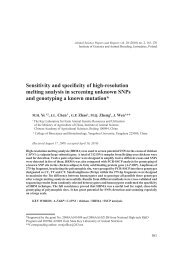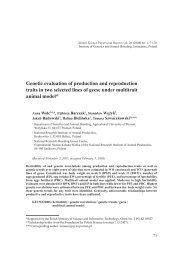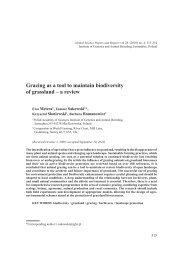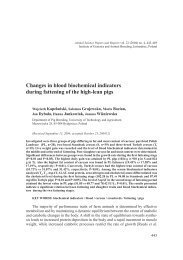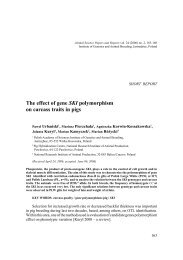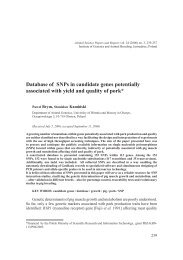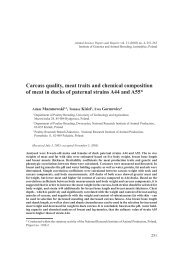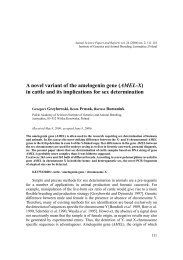A note on inbreeding effect on productive and reproductive traits in ...
A note on inbreeding effect on productive and reproductive traits in ...
A note on inbreeding effect on productive and reproductive traits in ...
Create successful ePaper yourself
Turn your PDF publications into a flip-book with our unique Google optimized e-Paper software.
Animal Science Papers <strong>and</strong> Reports vol. 21 (2003) no. 2, 121-129<br />
Institute of Genetics <strong>and</strong> Animal Breed<strong>in</strong>g, Jastrzębiec, Pol<strong>and</strong><br />
A <str<strong>on</strong>g>note</str<strong>on</strong>g> <strong>on</strong> <strong><strong>in</strong>breed<strong>in</strong>g</strong> <strong>effect</strong> <strong>on</strong> <strong>productive</strong><br />
<strong>and</strong> re<strong>productive</strong> <strong>traits</strong> <strong>in</strong> lay<strong>in</strong>g hens<br />
Tomasz Szwaczkowski 1 , Katarzyna Cywa-Benko 2 , Stanisław Wężyk 2<br />
1<br />
Department of Genetics <strong>and</strong> Animal Breed<strong>in</strong>g,<br />
The August Cieszkowski Agricultural University of Poznań,<br />
Wołyńska 33, 60-637 Pol<strong>and</strong>, Pol<strong>and</strong><br />
2<br />
Department of Poultry Breed<strong>in</strong>g, Nati<strong>on</strong>al Institute of Animal Producti<strong>on</strong>,<br />
Krakowska 1, 32-083 Balice/Cracov, Pol<strong>and</strong><br />
(Received May 9, 2003; accepted June 6, 2003)<br />
Inbreed<strong>in</strong>g rate <strong>and</strong> <strong>effect</strong>s <strong>on</strong> producti<strong>on</strong> (body weight, age at first egg, egg weight), <strong>and</strong> reproducti<strong>on</strong><br />
(per cent of eggs fertilized, per cent of eggs hatched as related to eggs set) <strong>traits</strong> were evaluated<br />
<strong>in</strong> 9194 layers bel<strong>on</strong>g<strong>in</strong>g to two stra<strong>in</strong>s. The <strong>in</strong>dividual <strong><strong>in</strong>breed<strong>in</strong>g</strong> coefficients were calculated us<strong>in</strong>g<br />
Wright’s formula from available performance records across n<strong>in</strong>e generati<strong>on</strong>s. The <strong><strong>in</strong>breed<strong>in</strong>g</strong> <strong>effect</strong>s<br />
(<strong>in</strong>clud<strong>in</strong>g l<strong>in</strong>ear covariable) were estimated by derivative-free restricted maximum likelihood<br />
algorithm under an animal model.<br />
In general, the <strong><strong>in</strong>breed<strong>in</strong>g</strong> level appeared relatively low <strong>in</strong> both populati<strong>on</strong>s. The <strong><strong>in</strong>breed<strong>in</strong>g</strong> depressi<strong>on</strong>s<br />
for the <strong>traits</strong> studied (except per cent of eggs fertilized) were found low. The heritability estimates<br />
of <strong>productive</strong> <strong>and</strong> re<strong>productive</strong> <strong>traits</strong> corresp<strong>on</strong>ded with those reported <strong>in</strong> literature.<br />
KEY WORDS: chicken / heritability / <strong><strong>in</strong>breed<strong>in</strong>g</strong> / lay<strong>in</strong>g performance<br />
Genetic improvement of livestock <strong>and</strong> poultry is based <strong>on</strong> two alternative approaches:<br />
crossbreed<strong>in</strong>g <strong>and</strong> selecti<strong>on</strong>. Crossbreed<strong>in</strong>g leads to the creati<strong>on</strong> of more heterozygotes<br />
<strong>and</strong> <strong>in</strong> c<strong>on</strong>sequence to greater genetic variati<strong>on</strong> of populati<strong>on</strong>. By c<strong>on</strong>trast, selecti<strong>on</strong> determ<strong>in</strong>es<br />
both genetic ga<strong>in</strong> <strong>and</strong> <strong><strong>in</strong>breed<strong>in</strong>g</strong> rate. The <strong><strong>in</strong>breed<strong>in</strong>g</strong> <strong>effect</strong>s <strong>in</strong>clude <strong>in</strong>creased<br />
homozygosity, a higher risk for the <strong>in</strong>cidence of lethal or deleterious recessive alleles,<br />
<strong>and</strong> decrease <strong>in</strong> performance <strong>and</strong> fitness <strong>traits</strong> [Milgior et al. 1995]. On the other h<strong>and</strong>,<br />
mat<strong>in</strong>g of relatives has been used over the last centuries to produce breeds, varieties<br />
<strong>and</strong> l<strong>in</strong>es.<br />
121
T. Szwaczkowski et al.<br />
In recent years, a number of studies <strong>on</strong> <strong><strong>in</strong>breed<strong>in</strong>g</strong> <strong>effect</strong>s <strong>in</strong> livestock <strong>and</strong> poultry<br />
populati<strong>on</strong>s have been performed [Klemetsdal 1998, Thomps<strong>on</strong> et al. 2000a, 2000b].<br />
Inbreed<strong>in</strong>g depressi<strong>on</strong> <strong>in</strong> re<strong>productive</strong> <strong>and</strong> <strong>productive</strong> <strong>traits</strong> has been reported by<br />
Flock et al. [1991] <strong>and</strong> Smith et al. [1998]. Therefore, from the current perspective,<br />
the <strong><strong>in</strong>breed<strong>in</strong>g</strong> rate is perceived as negative, especially for small, closed populati<strong>on</strong>s.<br />
Hence, mat<strong>in</strong>g designs with c<strong>on</strong>stra<strong>in</strong>ts of <strong><strong>in</strong>breed<strong>in</strong>g</strong> level are developed [Oyama <strong>and</strong><br />
Mukai 1998, Nomura 1998]. C<strong>on</strong>trary to livestock, lay<strong>in</strong>g hens are characterized by<br />
some <strong>traits</strong> (e.g. short generati<strong>on</strong> <strong>in</strong>terval) which lead to an <strong>in</strong>crease <strong>in</strong> the <strong><strong>in</strong>breed<strong>in</strong>g</strong><br />
rate. Jeyaruban et al. [1995] reported that the use of best l<strong>in</strong>ear unbiased predicti<strong>on</strong><br />
(BLUP) <strong>in</strong>duced larger <strong><strong>in</strong>breed<strong>in</strong>g</strong> rate compared to selecti<strong>on</strong> resp<strong>on</strong>se, especially for<br />
<strong>traits</strong> of low heritability.<br />
The objective of this study was to evaluate an <strong><strong>in</strong>breed<strong>in</strong>g</strong> rate <strong>and</strong> <strong><strong>in</strong>breed<strong>in</strong>g</strong> <strong>effect</strong>s<br />
<strong>on</strong> some producti<strong>on</strong> <strong>and</strong> reproducti<strong>on</strong> layer <strong>traits</strong>. The heritabilities of <strong>traits</strong> studied have<br />
also been estimated.<br />
Material <strong>and</strong> methods<br />
The report is based <strong>on</strong> 9194 performance records of two stra<strong>in</strong>s (H77 – White<br />
Leghorn <strong>and</strong> N88 – New Hampshire) of lay<strong>in</strong>g hens kept <strong>on</strong> a pedigree farm for n<strong>in</strong>e<br />
generati<strong>on</strong>s (years). The number of observati<strong>on</strong>s per generati<strong>on</strong> (year) was relatively<br />
small because <strong>on</strong>ly dams were recorded. The number of <strong>in</strong>dividuals per year (with<strong>in</strong><br />
stra<strong>in</strong>) was approximately equal. However, to detect the <strong><strong>in</strong>breed<strong>in</strong>g</strong> rate, pedigree<br />
<strong>in</strong>formati<strong>on</strong> <strong>on</strong> sires, <strong>in</strong>clud<strong>in</strong>g their parents, was added to the data set.<br />
The chickens were naturally mated (<strong>on</strong>e male was mated to ten females) <strong>and</strong> kept<br />
<strong>on</strong> litter. The envir<strong>on</strong>mental c<strong>on</strong>diti<strong>on</strong>s did not c<strong>on</strong>siderably change over the generati<strong>on</strong>s.<br />
The follow<strong>in</strong>g <strong>traits</strong> were analysed: body weight (BW), age at first egg (AFE), egg<br />
weight (EW), per cent of eggs fertilized (PEF) <strong>and</strong> per cent of eggs hatched as related<br />
to eggs set (PEH). A brief statistical descripti<strong>on</strong> of the data sets is given <strong>in</strong> Table 1.<br />
The <strong><strong>in</strong>breed<strong>in</strong>g</strong> coefficients of <strong>in</strong>dividuals were calculated by Wright’s approach<br />
122
Effect of <strong><strong>in</strong>breed<strong>in</strong>g</strong> <strong>on</strong> producti<strong>on</strong> <strong>and</strong> reproducti<strong>on</strong> <strong>in</strong> lay<strong>in</strong>g hens<br />
from available pedigree data across n<strong>in</strong>e generati<strong>on</strong>s. The <strong><strong>in</strong>breed<strong>in</strong>g</strong> coefficients were<br />
expressed as per cent.<br />
The follow<strong>in</strong>g unitrait animal l<strong>in</strong>ear model was employed:<br />
where:<br />
y ijk<br />
= µ + s i<br />
+ p j<br />
+ bx ijk<br />
+ a ijk<br />
+ e ijk<br />
y ijk<br />
– an observati<strong>on</strong> of ijk-th <strong>in</strong>dividual,<br />
µ – overall mean;<br />
r j<br />
– fixed <strong>effect</strong> of i-th generati<strong>on</strong> (i = 1, 2, ..., 9);<br />
p j<br />
– fixed <strong>effect</strong> of j-th hatch period (j = 1, 2, ..., 4);<br />
b – coefficient of partial l<strong>in</strong>ear regressi<strong>on</strong>;<br />
x ijk<br />
– <strong><strong>in</strong>breed<strong>in</strong>g</strong> coefficient of ijk-th <strong>in</strong>dividual;<br />
a ijk<br />
– r<strong>and</strong>om genetic additive <strong>effect</strong> of ijk-th <strong>in</strong>dividual;<br />
e ijk<br />
– r<strong>and</strong>om error associated with ijk-th observati<strong>on</strong>,<br />
Computati<strong>on</strong>s were performed us<strong>in</strong>g the DFREML package programmes of<br />
Meyer [2001].<br />
Results <strong>and</strong> discussi<strong>on</strong><br />
Inbreed<strong>in</strong>g rate<br />
The number of <strong>in</strong>bred <strong>in</strong>dividuals <strong>and</strong> mean <strong><strong>in</strong>breed<strong>in</strong>g</strong> coefficients over generati<strong>on</strong>s<br />
are presented <strong>in</strong> Figures 1 <strong>and</strong> 2. Null <strong><strong>in</strong>breed<strong>in</strong>g</strong> levels <strong>in</strong> the first two generati<strong>on</strong>s<br />
were <strong>in</strong>fluenced by available pedigree <strong>in</strong>formati<strong>on</strong> (birds from generati<strong>on</strong> 0 were treated<br />
as base). Generally, <strong>in</strong> both stra<strong>in</strong>s, the <strong><strong>in</strong>breed<strong>in</strong>g</strong> rates <strong>in</strong>creased, while the number<br />
of <strong>in</strong>bred <strong>in</strong>dividuals <strong>in</strong>creased up to the generati<strong>on</strong> 6 <strong>and</strong> then gradually decreased<br />
<strong>in</strong> the further years. This <strong>in</strong>dicates that over the years the <strong><strong>in</strong>breed<strong>in</strong>g</strong> level of <strong>in</strong>bred<br />
<strong>in</strong>dividuals has <strong>in</strong>creased. Maximum annual mean <strong><strong>in</strong>breed<strong>in</strong>g</strong> level appeared lower <strong>in</strong><br />
stra<strong>in</strong> H77 (2.5%) than <strong>in</strong> N88 (3.5%), both be<strong>in</strong>g, as expected, negatively correlated<br />
with the number of <strong>in</strong>dividuals. In general, both <strong><strong>in</strong>breed<strong>in</strong>g</strong> levels may be c<strong>on</strong>sidered<br />
as low. It corresp<strong>on</strong>ds with results obta<strong>in</strong>ed by Wężyk et al. [2003] who for the same<br />
populati<strong>on</strong>s reported the so-called hypothetical <strong><strong>in</strong>breed<strong>in</strong>g</strong> levels per generati<strong>on</strong> (result<strong>in</strong>g<br />
from the number of sires <strong>and</strong> dams) be<strong>in</strong>g very similar to empiric <strong>on</strong>es. Majority of<br />
reports <strong>on</strong> <strong><strong>in</strong>breed<strong>in</strong>g</strong> rate <strong>in</strong> livestock <strong>and</strong> poultry populati<strong>on</strong>s <strong>in</strong>dicates the <strong>in</strong>crease<br />
of <strong><strong>in</strong>breed<strong>in</strong>g</strong> level over time [Sewalem 1998, Miglior et al. 1995]<br />
Inbreed<strong>in</strong>g <strong>effect</strong>s<br />
123
T. Szwaczkowski et al.<br />
Fig. 1. Inbreed<strong>in</strong>g rate <strong>in</strong> stra<strong>in</strong> H77.<br />
Fig. 2. Inbreed<strong>in</strong>g rate <strong>in</strong> stra<strong>in</strong> N88.<br />
Table 2 shows estimates of partial l<strong>in</strong>ear regressi<strong>on</strong> coefficients between <strong><strong>in</strong>breed<strong>in</strong>g</strong><br />
level (%) <strong>and</strong> performance <strong>traits</strong>. Differences between stra<strong>in</strong>s were found for the majority<br />
of <strong>traits</strong> studied, po<strong>in</strong>t<strong>in</strong>g to different genetic orig<strong>in</strong> of the stra<strong>in</strong>s. Stra<strong>in</strong> H77 has been<br />
directly selected for egg producti<strong>on</strong>, whereas N88 for more performance <strong>traits</strong>.<br />
In both populati<strong>on</strong>s the deepest <strong><strong>in</strong>breed<strong>in</strong>g</strong> depressi<strong>on</strong> was observed for PEF. Each<br />
124
Effect of <strong><strong>in</strong>breed<strong>in</strong>g</strong> <strong>on</strong> producti<strong>on</strong> <strong>and</strong> reproducti<strong>on</strong> <strong>in</strong> lay<strong>in</strong>g hens<br />
1% of <strong><strong>in</strong>breed<strong>in</strong>g</strong> of the layer resulted <strong>in</strong> almost 1.0% <strong>and</strong> 0.4% decrease <strong>in</strong> fertilized<br />
eggs <strong>in</strong> N88 <strong>and</strong> H77 stra<strong>in</strong>, respectively. Different partial regressi<strong>on</strong> coefficients (across<br />
stra<strong>in</strong>s) have been estimated for other <strong>traits</strong>, for <strong>in</strong>stance <strong>in</strong> PEH. Various <strong><strong>in</strong>breed<strong>in</strong>g</strong><br />
<strong>effect</strong>s <strong>on</strong> some re<strong>productive</strong> <strong>traits</strong> across chicken l<strong>in</strong>es were estimated by a number<br />
of authors [Nordskog <strong>and</strong> Shen Cheng 1988, Gowe et al. 1993, Sewalem et al. 1999].<br />
On the other h<strong>and</strong> Hagger et al. [1986] c<strong>on</strong>cluded that <strong><strong>in</strong>breed<strong>in</strong>g</strong> was not important<br />
for embry<strong>on</strong>ic viability over the extreme range of egg weight. It seems that c<strong>on</strong>trary<br />
to mammals, birds can be more resp<strong>on</strong>sive to <strong><strong>in</strong>breed<strong>in</strong>g</strong> rate. This also corresp<strong>on</strong>ds<br />
with a greater resp<strong>on</strong>se to chromosomal aberrati<strong>on</strong>s <strong>in</strong> birds described by Sysa <strong>and</strong><br />
Jaszczak [1997].<br />
Relatively small or moderate <strong><strong>in</strong>breed<strong>in</strong>g</strong> <strong>effect</strong>s were observed for <strong>traits</strong> <strong>in</strong>cluded<br />
<strong>in</strong> the selecti<strong>on</strong> <strong>in</strong>dex. For <strong>in</strong>stance, 1% <strong>in</strong>crease of <strong><strong>in</strong>breed<strong>in</strong>g</strong> <strong>in</strong> layers led to 4 g <strong><strong>in</strong>breed<strong>in</strong>g</strong><br />
depressi<strong>on</strong> <strong>in</strong> BW for H77 stra<strong>in</strong>. However, for AFE <strong>and</strong> EW the <strong><strong>in</strong>breed<strong>in</strong>g</strong><br />
<strong>effect</strong>s were found positive. Reverse relati<strong>on</strong>ships were obta<strong>in</strong>ed <strong>in</strong> stra<strong>in</strong> N88.<br />
The annual means of <strong>traits</strong> studied are listed <strong>in</strong> Table 3. The means fluctuated negligibly<br />
over generati<strong>on</strong>s. It seems that these changes were <strong>in</strong>fluenced by the <strong><strong>in</strong>breed<strong>in</strong>g</strong><br />
rate. Piotrowski (unpublished data) reported positive genetic trends for PEF <strong>and</strong> PEH<br />
<strong>in</strong> the same two populati<strong>on</strong>s. Genetic trends for BW, AFE <strong>and</strong> EW were moderate.<br />
In general, the <strong><strong>in</strong>breed<strong>in</strong>g</strong> <strong>effect</strong>s <strong>in</strong> the populati<strong>on</strong>s studied were mean<strong>in</strong>gless,<br />
except for c<strong>on</strong>siderable <strong><strong>in</strong>breed<strong>in</strong>g</strong> depressi<strong>on</strong> obta<strong>in</strong>ed for PEF. However, Jeyaruban<br />
et al. [1995] po<strong>in</strong>ted out that <strong>in</strong>tensive selecti<strong>on</strong> based <strong>on</strong> BLUP led to a high <strong><strong>in</strong>breed<strong>in</strong>g</strong><br />
rate (about 15%) whereas the genetic ga<strong>in</strong> reached <strong>on</strong>ly 5%. Hence, the <strong><strong>in</strong>breed<strong>in</strong>g</strong> <strong>effect</strong><br />
obta<strong>in</strong>ed can be affected by selecti<strong>on</strong> <strong>in</strong>tensity applied to the stra<strong>in</strong>s studied. From<br />
a statistical po<strong>in</strong>t of view, a relatively low <strong><strong>in</strong>breed<strong>in</strong>g</strong> level of both populati<strong>on</strong>s studied<br />
is not suitable for evaluat<strong>in</strong>g the <strong><strong>in</strong>breed<strong>in</strong>g</strong> <strong>effect</strong>s.<br />
Estimates of heritabilities<br />
A number of reports <strong>on</strong> heritability estimates of <strong>productive</strong> <strong>and</strong> re<strong>productive</strong> <strong>traits</strong><br />
<strong>in</strong> lay<strong>in</strong>g hens have appeared <strong>in</strong> literature [e.g. Szwaczkowski 2003], <strong>and</strong> many of the<br />
genetic <strong>and</strong> envir<strong>on</strong>mental variance estimates may be helpful <strong>in</strong> the analysis of <strong><strong>in</strong>breed<strong>in</strong>g</strong><br />
<strong>effect</strong>s. It is well known that <strong>in</strong>creased <strong><strong>in</strong>breed<strong>in</strong>g</strong> leads to decreased genetic variati<strong>on</strong>. As<br />
listed <strong>in</strong> Table 4, relatively high heritability estimates were obta<strong>in</strong>ed for BW (0.461 <strong>and</strong><br />
125
126<br />
T. Szwaczkowski et al.
Effect of <strong><strong>in</strong>breed<strong>in</strong>g</strong> <strong>on</strong> producti<strong>on</strong> <strong>and</strong> reproducti<strong>on</strong> <strong>in</strong> lay<strong>in</strong>g hens<br />
0.421 for H77 <strong>and</strong> N88, respectively). This corroborates the results obta<strong>in</strong>ed by Besbes et<br />
al. [1992] <strong>and</strong> Tufvess<strong>on</strong> et al. [1999]. However, Szydłowski <strong>and</strong> Szwaczkowski [2001]<br />
reported lower Bayesian estimates of heritability for BW of two Polish stra<strong>in</strong>s of lay<strong>in</strong>g<br />
hens. The estimates of heritabilities for age at first egg obta<strong>in</strong>ed by other authors [Sewalem<br />
1998, Szwaczkowski et al. 2001] showed variati<strong>on</strong> rang<strong>in</strong>g from 0.08 to 0.44.<br />
Heritabilities of PEF <strong>and</strong> PEH (Tab. 4) are <strong>in</strong> general agreement with results by other<br />
authors for different populati<strong>on</strong>s [Sewalem et al. 1998, Szwaczkowski et al. 2000].<br />
From a methodological po<strong>in</strong>t of view it should be <str<strong>on</strong>g>note</str<strong>on</strong>g>d that these data have not been<br />
transformed. It is known that some layer <strong>traits</strong> exhibit deviati<strong>on</strong>s from normality. This led<br />
to overestimati<strong>on</strong> of mean square of residuals <strong>and</strong>, <strong>in</strong> c<strong>on</strong>sequence, to underestimati<strong>on</strong><br />
of heritability. However, from the breeder’s perspective an <strong>in</strong>terpretati<strong>on</strong> of <strong><strong>in</strong>breed<strong>in</strong>g</strong><br />
<strong>effect</strong>s could be difficult, as transformed are also natural units of <strong>traits</strong> studied. Piotrowski<br />
<strong>and</strong> Szwaczkowski [2002] <strong>in</strong>dicated similar estimates of variance comp<strong>on</strong>ents obta<strong>in</strong>ed<br />
from untransformed vs transformed data.<br />
The results presented here lead to the follow<strong>in</strong>g c<strong>on</strong>clusi<strong>on</strong>s.<br />
The <strong><strong>in</strong>breed<strong>in</strong>g</strong> level seems to be relatively low <strong>in</strong> these populati<strong>on</strong>s, undergo<strong>in</strong>g<br />
selecti<strong>on</strong>. The <strong><strong>in</strong>breed<strong>in</strong>g</strong> depressi<strong>on</strong>s for the <strong>traits</strong> studied (except per cent of eggs<br />
fertilized) are mean<strong>in</strong>gless. The heritability estimates of <strong>productive</strong> <strong>and</strong> re<strong>productive</strong><br />
<strong>traits</strong> corresp<strong>on</strong>d to those reported <strong>in</strong> literature.<br />
Acknowledgement. The authors are grateful to Dr. Kar<strong>in</strong> Meyer for supply<strong>in</strong>g a<br />
set of DFREML programmes.<br />
REFERENCES<br />
1. BESBES B., DUCROCQ V., FOULLEY J.L., PROTAIS M., TAVERNIER A., TIXIER-BOICHARD<br />
M., BEAUMONT C., 1992 – Estimati<strong>on</strong> of genetic parameters of egg producti<strong>on</strong> <strong>traits</strong> of lay<strong>in</strong>g<br />
hens by restricted maximum likelihood applied to a multiple-trait reduced animal model. Genetics,<br />
Selecti<strong>on</strong>, Evoluti<strong>on</strong> 24, 539-552.<br />
2. FLOCK D.K., AMELI H., GLODEK P., 1991 – Inbreed<strong>in</strong>g <strong>and</strong> heterosis <strong>effect</strong>s <strong>on</strong> quantitative<br />
<strong>traits</strong> <strong>in</strong> a white leghorn populati<strong>on</strong> under l<strong>on</strong>g-term reciprocal recurrent selecti<strong>on</strong>. British Poultry<br />
Science 32, 451-462.<br />
127
T. Szwaczkowski et al.<br />
3. GOWE R.S., FAIRFULL R.W., MCMILLAN I., SCHMIDT G.S., 1993 – A strategy for ma<strong>in</strong>ta<strong>in</strong><strong>in</strong>g<br />
high fertility <strong>and</strong> hatchability <strong>in</strong> a multiple-trait egg stock selecti<strong>on</strong> program. Poultry Science 72,<br />
1433-1448.<br />
4. HAGGER C., STEIGER-STAFL D., MARGURAT C., 1986 – Embry<strong>on</strong>ic mortality <strong>in</strong> chicken eggs<br />
as <strong>in</strong>fluenced by egg weight <strong>and</strong> <strong><strong>in</strong>breed<strong>in</strong>g</strong>. Poultry Science 35, 812-821.<br />
5. JEYARUBAN M.G., GIBSON J.P., GOWE R.S., 1995 – Comparis<strong>on</strong> of <strong>in</strong>dex selecti<strong>on</strong> <strong>and</strong> best<br />
l<strong>in</strong>ear unbiased predicti<strong>on</strong> for simulated layer poultry data. Poultry Science 74, 1566-1576.<br />
6. KLEMETSDAL G., 1998 – The <strong>effect</strong> of <strong><strong>in</strong>breed<strong>in</strong>g</strong> <strong>on</strong> rac<strong>in</strong>g performance <strong>in</strong> Norwegian cold-blooded<br />
trotters. Genetics, Selecti<strong>on</strong>, Evoluti<strong>on</strong> 30, 351-366.<br />
7. MEYER K., 2001 – Programs to estimate variance comp<strong>on</strong>ents for <strong>in</strong>dividual animal models by restricted<br />
maximum likelihood (REML). User <str<strong>on</strong>g>note</str<strong>on</strong>g>s. Institute of Animal Science, Armidale, Australia.<br />
8. MIGLIOR F., BURNSIDE E.B., DEKKERS J.C.M., 1995 – Inbreed<strong>in</strong>g of Canadian Holste<strong>in</strong> cattle.<br />
Journal of Dairy Science 78, 1168-1167.<br />
9. NOMURA T., 1998 – A mat<strong>in</strong>g system to reduce <strong><strong>in</strong>breed<strong>in</strong>g</strong> <strong>in</strong> selecti<strong>on</strong> programmes: theoretical<br />
basis <strong>and</strong> modificati<strong>on</strong> of compensatory mat<strong>in</strong>g. Journal of Animal Breed<strong>in</strong>g <strong>and</strong> Genetics 116,<br />
351-362.<br />
10. NORDSKOG A.W., CHENG S., 1988 – Inbreed<strong>in</strong>g <strong>effect</strong>s <strong>on</strong> fertility <strong>and</strong> hatchability associated<br />
with the formati<strong>on</strong> of subl<strong>in</strong>es. Poultry Science 67, 859-864.<br />
11. OYAMA K., MUKAI F., 1998 – Determ<strong>in</strong>ati<strong>on</strong> of the optimum mat<strong>in</strong>g design with c<strong>on</strong>stra<strong>in</strong>ts <strong>on</strong><br />
<strong><strong>in</strong>breed<strong>in</strong>g</strong> level <strong>and</strong> mat<strong>in</strong>g frequency of sires via a simple genetic algorithm. Animal Science <strong>and</strong><br />
Technology 69, 333-340.<br />
12. PIOTROWSKI P., SZWACZKOWSKI T., 2002 – Impact of data transformati<strong>on</strong> <strong>on</strong> the heritability<br />
estimates of re<strong>productive</strong> <strong>traits</strong> <strong>in</strong> lay<strong>in</strong>g hens. Journal of Animal <strong>and</strong> Feed Sciences 11, 137-147.<br />
13. SMITH L.A., CASSELL B.G., PEARSON R.E., 1998 – The <strong>effect</strong>s of <strong><strong>in</strong>breed<strong>in</strong>g</strong> <strong>on</strong> the lifetime<br />
performance of dairy cattle. Journal of Dairy Science 81, 2729-2737.<br />
14. SEWALEM A., 1998 – Genetic study of reproducti<strong>on</strong> <strong>traits</strong> <strong>and</strong> their relati<strong>on</strong>ship to producti<strong>on</strong> <strong>traits</strong><br />
<strong>in</strong> White Leghorn l<strong>in</strong>es. PhD Thesis. Swedish University of Agricultural Science, Uppsala, Sweden.<br />
15. SEWALEM A., JOHANSSON K., WILHELMSON M., LIPPERS K., 1999 – Inbreed<strong>in</strong>g <strong>and</strong><br />
<strong><strong>in</strong>breed<strong>in</strong>g</strong> depressi<strong>on</strong> <strong>on</strong> reproducti<strong>on</strong> <strong>and</strong> producti<strong>on</strong> <strong>traits</strong> of White Leghorn l<strong>in</strong>es selected for egg<br />
producti<strong>on</strong> <strong>traits</strong>. British Poultry Science 40, 203-208<br />
16. SYSA P.S., JASZCZAK K., 1997 – Wykorzystanie badań cytogenetycznych w hodowli i selekcji<br />
zwierząt (The Use of Cytogenetic Investigati<strong>on</strong>s <strong>in</strong> Breed<strong>in</strong>g <strong>and</strong> Selecti<strong>on</strong> of Animals). In: Biotechnologia<br />
Zwierząt (Animal Biotechnology) (L. Zwierzchowski, K. Jaszczak, J.A. Modliński, Eds.). In<br />
Polish. Wydawnictwo Naukowe PWN, pp. 89-118.<br />
17. SZWACZKOWSKI T., 2003 – Use of Mixed Model Methodology <strong>in</strong> Poultry Breed<strong>in</strong>g: Estimati<strong>on</strong><br />
of Genetic Parameters. In: Poultry Genetics, Breed<strong>in</strong>g <strong>and</strong> Biotechnology (W.M. Muir <strong>and</strong> S.E. Aggrey,<br />
Eds.). CAB Internati<strong>on</strong>al; 11, 165-201.<br />
18. SZWACZKOWSKI T., WĘŻYK S., PIOTROWSKI P., CYWA-BENKO K., 2000 – Direct <strong>and</strong><br />
maternal genetic <strong>and</strong> envir<strong>on</strong>mental <strong>effect</strong>s of fertility <strong>and</strong> hatchability <strong>in</strong> lay<strong>in</strong>g hens. Archiv fur<br />
Geflugelkunde 34 (3), 115-120.<br />
19. SZYDŁOWSKI M., SZWACZKOWSKI T., 2001 – Bayesian segregati<strong>on</strong> analysis of producti<strong>on</strong><br />
<strong>traits</strong> of lay<strong>in</strong>g hens. Poultry Science 80, 125-131.<br />
20. SZWACZKOWSKI T., SZYDŁOWSKI M. MOLIŃSKI K., DOBEK A., 2001 – Multivariate<br />
analysis of mixed <strong>in</strong>heritance model of performance <strong>traits</strong> <strong>in</strong> layers us<strong>in</strong>g Gibbs sampl<strong>in</strong>g. Journal<br />
of Animal Breed<strong>in</strong>g <strong>and</strong> Genetics 118, 205-211.<br />
21. THOMPSON J.R., EVERETT R.W., WOLFE C.W., 2000a – Effects of <strong><strong>in</strong>breed<strong>in</strong>g</strong> <strong>on</strong> producti<strong>on</strong><br />
<strong>and</strong> survival <strong>in</strong> Jerseys. Journal of Dairy Science 83, 2131-2138.<br />
128
Effect of <strong><strong>in</strong>breed<strong>in</strong>g</strong> <strong>on</strong> producti<strong>on</strong> <strong>and</strong> reproducti<strong>on</strong> <strong>in</strong> lay<strong>in</strong>g hens<br />
22. THOMPSON J.R., EVERETT R.W., HAMMERSCHMIDT N.L., 2000b – Effects of <strong><strong>in</strong>breed<strong>in</strong>g</strong> <strong>on</strong><br />
producti<strong>on</strong> <strong>and</strong> survival <strong>in</strong> Holste<strong>in</strong>s. Journal of Dairy Science 83, 1856-1864.<br />
23. TUFVESSON M., TUFVESSON B., SCHANTZ T., JOHANSSON K., WILHELMSON M., 1999<br />
– Selecti<strong>on</strong> for sexual male characters <strong>and</strong> their <strong>effect</strong>s <strong>on</strong> other fitness related <strong>traits</strong> <strong>in</strong> white leghorn<br />
chickens. Journal of Animal Breed<strong>in</strong>g <strong>and</strong> Genetics 116, 127-138.<br />
24. WĘŻYK S., BRESIŃSKA A., CYWA-BENKO K., SZWACZKOWSKI T., 2003 – Hipotetyczny<br />
i rzeczywisty poziom z<strong>in</strong>bredowania w wybranych populacjach kur nieśnych. Zeszyty Naukowe<br />
Przeglądu Hodowlanego (<strong>in</strong> press).<br />
Tomasz Szwaczkowski, Katarzyna Cywa-Benko, Stanisław Wężyk<br />
Wpływ <strong>in</strong>bredu na cechy produkcyjne i reprodukcyjne kur nieśnych<br />
S t r e s z c z e n i e<br />
Dok<strong>on</strong>ano oceny poziomu <strong>in</strong>bredu i oszacowano jego wpływ na masę ciała (BW), wiek zniesienia<br />
pierwszego jaja (AFE), średnią masę jaja (EW), procent zapłodnienia jaj (PEF) i procent wylęgu z jaj<br />
nałoż<strong>on</strong>ych (PEH). Obserwacje pochodziły od 9194 kur rodu H77 i N88. Współczynniki <strong>in</strong>bredu oblicz<strong>on</strong>o<br />
stosując wzory Wrighta. Poziom <strong>in</strong>bredu uwzględni<strong>on</strong>o w l<strong>in</strong>iowym modelu zwierzęcia jako zmienną<br />
kowariancyjną. Stwierdz<strong>on</strong>o dość niski (jednak z tendencją wzrostową) poziom z<strong>in</strong>bredowania, nie<br />
przekraczający 3.5%. Generalnie, efekty <strong>in</strong>bredu były niewielkie (z wyjątkiem procentu zapłodnienia jaj).<br />
Oszacowane estymatory odziedziczalności cech koresp<strong>on</strong>dowały z danymi zawartymi w piśmiennictwie.<br />
129
130



